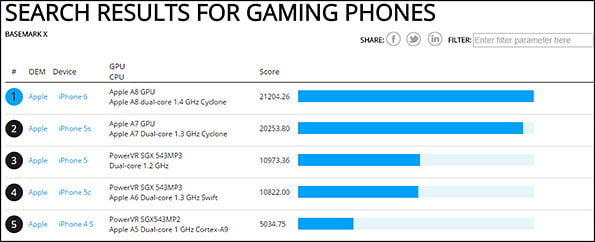Historically speaking, we typically see impressive performance gains each time Applereleases a new custom processor for its mobile products. Certainly that was true of the A7 System-on-Chip (SoC), the world's first 64-bit smartphone processor offering desktop-class performance. In our evaluation of the iPhone 5s, the A7 chip dominated our benchmark runs and consistently outperformed previous generation iPhone models, sometimes by an obscene margin. So, can we expect the same kind of performance bump from the iPhone 6 and iPhone 6 Plus, both of which sport a custom A8 SoC? Maybe not.
Rightware ran the iPhone 6 through its Basemark X benchmark and noted only modest gains compared to theiPhone 5s. Armed with a dual-core 1.4GHz Cyclone CPU and A8 GPU, the iPhone 6 scored 21,204.26 and a earned a place at the top of the chart, though not by much. By comparison, the iPhone 5s scored 20,253.80 in the same benchmark. In other words, the iPhone 6 is less than 5 percent faster than the iPhone 5s, at least in Basemark X.
This is surprising, both to us and Rightware, which told HotHardware that the performance improvement wasn't as big as it was expecting. That's probably true of anyone who's familiar with Apple's past upgrades, as well as those who caught the iPhone 6 launch live stream.

"The all-new A8 chip is our fastest yet. Its CPU and graphics performance are faster than on the A7 chip, even while powering a larger display and incredible new features. And because it’s designed to be so power efficient, the A8 chip can sustain higher performance — so you can play graphics-intensive games or enjoy video at higher frame rates for longer than ever," Apple states.
Apple's A8 chip is built on a 20nm process with two billion transistors. According to Apple, it offers 84x faster graphics performance than the original iPhone and is up to 50x faster in CPU performance. While that may be the case, the original iPhone is ancient technology. Of more interest is how it compares to today's devices and the previous generation iPhone. Unfortunately, early indications don't look all that promising, though we'll reserve judgement until we see more benchmarks emerge (and/or we have a chance to test it out for ourselves).
Rightware ran the iPhone 6 through its Basemark X benchmark and noted only modest gains compared to theiPhone 5s. Armed with a dual-core 1.4GHz Cyclone CPU and A8 GPU, the iPhone 6 scored 21,204.26 and a earned a place at the top of the chart, though not by much. By comparison, the iPhone 5s scored 20,253.80 in the same benchmark. In other words, the iPhone 6 is less than 5 percent faster than the iPhone 5s, at least in Basemark X.
This is surprising, both to us and Rightware, which told HotHardware that the performance improvement wasn't as big as it was expecting. That's probably true of anyone who's familiar with Apple's past upgrades, as well as those who caught the iPhone 6 launch live stream.

"The all-new A8 chip is our fastest yet. Its CPU and graphics performance are faster than on the A7 chip, even while powering a larger display and incredible new features. And because it’s designed to be so power efficient, the A8 chip can sustain higher performance — so you can play graphics-intensive games or enjoy video at higher frame rates for longer than ever," Apple states.
Apple's A8 chip is built on a 20nm process with two billion transistors. According to Apple, it offers 84x faster graphics performance than the original iPhone and is up to 50x faster in CPU performance. While that may be the case, the original iPhone is ancient technology. Of more interest is how it compares to today's devices and the previous generation iPhone. Unfortunately, early indications don't look all that promising, though we'll reserve judgement until we see more benchmarks emerge (and/or we have a chance to test it out for ourselves).


No comments:
Post a Comment